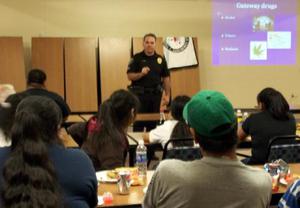Ak-Chin Indian Community’s Department of Education hosted its third quarter Parent Night Wednesday to promote awareness of issues affecting young adults, specifically drugs and their inherent dangers.
Education Director Jana Narcia welcomed parents and students, introducing Sgt. Steve Judd from the Maricopa Police Department, who presented information on “Teen Drug Use in Arizona,” outlining and discussing various ‘hard’ drugs and their effects.
In regard to the drug problem in general, Judd told the audience: “We need to know it’s out there; we need to be aware. It’s prevalent, and it’s dangerous.”
According to Judd, an estimated 2.5 million teens in the U.S. are addicted to hard drugs like cocaine, heroin, methamphetamines or club drugs like ecstasy or GHB (gammahydroxybutrate). Teens are 125 times more likely to do hard drugs if they smoke marijuana, and almost 100 percent of hard drug users go on to another harder drug, usually cocaine or heroin.
Judd asked one young lady what her favorite dessert was. “Pumpkin pie,” she replied.
“Would it be your favorite if you’d never tried it?” asked Judd, pointing to the fact that no one learns to like a drug unless they try it first.
One of the lesser-known facts about hard drug use is that addiction can occur after only one use. Currently, meth is the most popular drug because it is fairly cheap. It can be smoked, snorted, eaten or injected, but, said Judd, ”It’s also the most damaging.” He shared photos of the physical decline of a meth addict with weight loss, rotten teeth and sores all over her skin.
LSD, popular in the 60s, is also making a comeback in the drug world, but the effects can return any time—at the grocery store or in the boardroom—because the liver metabolizes it as another chemical, causing ‘flashbacks.’
Judd described Ecstasy as an “absolutely manmade drug” with no other purpose than to be sold and used. It has a meth component. Popular at teenage dance and drug parties, called Raves, it causes bruxism (teeth grinding) so teens often suck on lollipops or candy pacifiers.
Ecstasy is psychologically addictive. Users, experiencing euphoria and increased energy, learn to “love how they feel when they’re on it,” said Judd. Sometimes called the ‘love’ drug, users love to be touched because of heightened sensations and a lack of inhibitions. The drug also raises body temperatures two to four degrees, often resulting in dehydration and sometimes death.
Finally, GHB (the rape drug) is actually an animal tranquilizer used by veterinarians during animal treatment and surgeries. It is colorless and odorless with a slightly salty taste, almost impossible to detect if put into a can of soda or any drink. Because it is completely metabolized in three hours, detection is nearly impossible over time.
Judd’s advice to teens at social gatherings: “Never leave a drink unattended. If you can’t find an unopened can of soda, use your hands and drink out of a water faucet.”
“The drug problem is not going away,” warned Judd, noting that experts anticipate “a huge increase in mental illness due to drug use” in the next 15 or so years.
Following his presentation, Judd answered questions from the audience.
Refreshments were served to parents or guardians and the children who attended. In addition, several lucky winners took home Wal-Mart gift cards.
Photo by Joyce Hollis




![Maricopa sheds tears amid Maui wildfires that killed dozens For Maricopa resident Janelle Gomez, the sorrow mirrors the loss of a family member. [Brian Petersheim]](https://www.inmaricopa.com/wp-content/uploads/2023/08/Gomez-218x150.jpg)
![Embracing Freedom: Celebrating the Fourth of July Councilmember Vincent Manfredi at Great American 4th 2021 [Victor Moreno]](https://www.inmaricopa.com/wp-content/uploads/2023/07/2021-Great-American-4th-e1688414543522-218x150.jpg)












![Elena Trails releases home renderings An image of one of 56 elevation renderings submitted to Maricopa's planning department for the Elena Trails subdivison. The developer plans to construct 14 different floor plans, with four elevation styles per plan. [City of Maricopa]](https://www.inmaricopa.com/wp-content/uploads/2024/04/city-041724-elena-trails-rendering-100x70.jpg)